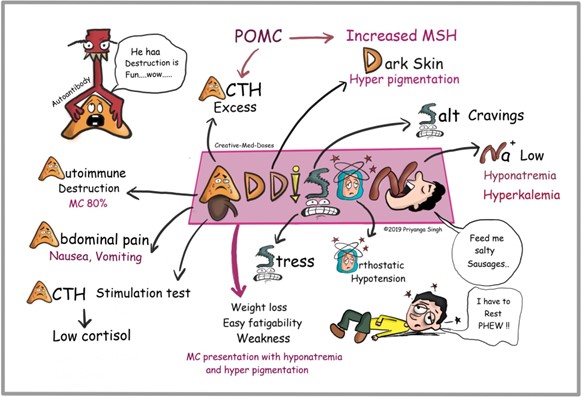A client presents at the emergency department reporting a raspy voice, cold intolerance, and fatigue. Laboratory tests indicate an elevated thyroid stimulating hormone (TSH) and low T3 and T4 levels. After the client is admitted to the telemetry unit, which intervention is most important for the nurse to implement?
Offer additional blankets and a warm drink.
Note the client's most recent hemoglobin level.
Administer prescribed dose of levothyroxine.
Assess for presence of non-pitting edema.
The Correct Answer is C
A) Incorrect- While providing comfort measures like blankets and warm drinks can help the client feel more comfortable, they do not address the underlying thyroid hormone imbalance.
B) Incorrect- Hemoglobin level is not directly related to the client's symptoms or the thyroid hormone imbalance. Monitoring hemoglobin is important in assessing anemia but is not the priority in this case.
C) Correct- The client's symptoms (raspy voice, cold intolerance, fatigue) along with an elevated TSH and low T3 and T4 levels suggest hypothyroidism. Levothyroxine is a synthetic thyroid hormone used to treat hypothyroidism. Administering the prescribed dose of levothyroxine is crucial to address the thyroid hormone imbalance and alleviate the symptoms.
D. Incorrect- Non-pitting edema is not a common symptom of hypothyroidism. The client's symptoms and lab results are more indicative of hypothyroidism, and addressing the thyroid hormone imbalance is the priority.
Nursing Test Bank
Naxlex Comprehensive Predictor Exams
Related Questions
Correct Answer is C
Explanation
The client with Addison's disease is experiencing weakness, confusion, and dehydration, which can be indicative of an adrenal crisis. The low sodium level (129 mEq/L) and low glucose level (54 mg/dl) further support this suspicion. An acute viral infection can trigger an adrenal crisis in individuals with Addison's disease.

Intravenous hydrocortisone, a glucocorticoid, is the treatment of choice for managing an adrenal crisis. It helps to replenish cortisol levels and stabilize the client's condition.
Hydrocortisone helps in restoring the body's stress response and regulating electrolyte and glucose levels.
A broad-spectrum antibiotic may be necessary if there is evidence of a bacterial infection, but it does not directly address the symptoms associated with Addison's disease.
Regular insulin is used for managing high blood glucose levels in conditions such as diabetes, but in this case, the client has low glucose levels, so insulin is not the appropriate intervention.
Potassium chloride is a medication used to treat low potassium levels (hypokalemia), but the client's potassium level is within the reference range (5.3 mEq/L). Therefore, potassium chloride is not indicated in this situation.
Correct Answer is ["A","B","D"]
Explanation
The correct answer isa. Place a bedside commode next to bed.,b. Measure neurological vital signs every 4 hours.,d. Encourage family to participate in the client’s care.
Choice A rationale:
Placing a bedside commode next to the bed helps prevent falls and promotes independence in toileting, which is crucial for stroke patients who may have mobility issues.
Choice B rationale:
Measuring neurological vital signs every 4 hours is essential to monitor for any changes in the patient’s condition, which can help in early detection of complications.
Choice C rationale:
Suctioning the oral cavity every 4 hours is not typically necessary unless the patient has specific issues with swallowing or secretion management.Routine suctioning can also cause discomfort and potential injury.
Choice D rationale:
Encouraging family to participate in the client’s care provides emotional support and helps in the rehabilitation process.Family involvement can improve the patient’s motivation and adherence to the rehabilitation plan.
Choice E rationale:
Playing classical music in the room can be soothing and beneficial for some patients, but it is not a standard intervention for stroke rehabilitation.The effectiveness of music therapy can vary based on individual preferences.
Whether you are a student looking to ace your exams or a practicing nurse seeking to enhance your expertise , our nursing education contents will empower you with the confidence and competence to make a difference in the lives of patients and become a respected leader in the healthcare field.
Visit Naxlex, invest in your future and unlock endless possibilities with our unparalleled nursing education contents today
Report Wrong Answer on the Current Question
Do you disagree with the answer? If yes, what is your expected answer? Explain.
Kindly be descriptive with the issue you are facing.
